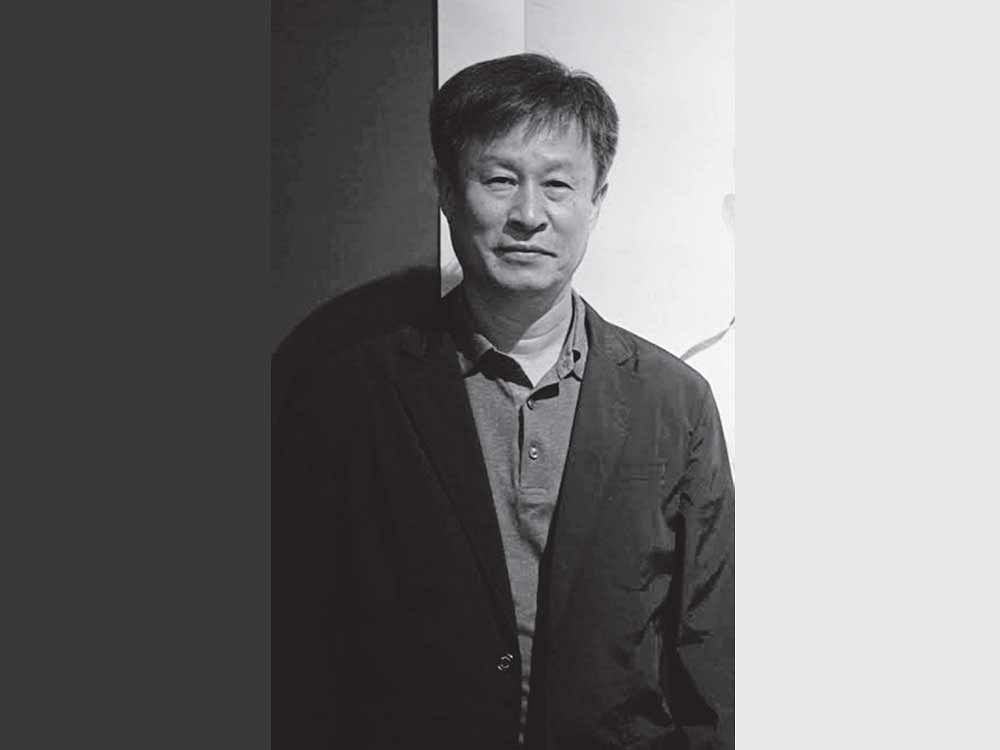I observe everything,” says South Korean artist Kim Ho-Suk. “Men, women, children, objects, insects, plants, historical movements, political agitations, social activism… The power of observation sustains me as an artist. It is my main artistic tool.”
Rendered with high precision, sensitivity and emotional intensity, Ho-Suk’s paintings are often dominated by traces, shadows and large blank spaces. Not always easy on the eye, his artistic output includes dead fish, writhing bees and cockroaches and skeletal remains of birds and animals. Signifying harsh realities of life, mindless existence and poignant memories, it also expounds aspects of the fragile human condition through allegorical symbols and metaphoric suggestions. Layered with subtle meanings, Ho-Suk’s images have the unique ability to charm and disturb the viewer at the same time. Adding to the intrigue is the string of thought-provoking titles.
Critics have observed how Ho-Suk’s work covers a range of contemporary themes; comments on moral, spiritual and political lacunae of the Korean society; and is deeply sympathetic to commoners, powerless and victims of abuse, neglect and oppression. “Ho-Suk’s detailed documentation of his people has become a diary of Korean life in the 20th century,” observed Professor Robert Fouser, in his essay titled Looking for the ‘Inner Being’ of Korea: Kim Ho-Suk.
The 60-year-old Korean artist who was named ‘Artist of the Year’ in 1998 and whose solo exhibition ‘Hiding Inside the Light’ concluded in Delhi recently, spoke to Sunday Herald about his long and eventful journey in the world of images. Here are some edited excerpts:
On his initiation into art
I was initiated into art at the tender age of five. Even as a child, I knew how to grind an ink stick, recite poems, and paint in response to poems narrated by my grandfather, a scholar of Chinese classics. I had a strict traditional upbringing, but on entering the university in a big city, I was confronted with a new reality. Roaming around Seoul, my life changed completely, as this was far removed from the rural life that I was hitherto part of.
Over time, I came to realise that even though there was an obligation to preserve traditional Korean painting in its purist form, there was also an added responsibility of making it relevant to modern times. It became impossible to disregard the reality that I lived in.
On his art practice
My inspiration comes from reading of history as well as contemporary events. My art is about representing the high spiritual values of Korean people; and seeking truth and justice in the present day milieu. I employ the medium of metaphors to convey my inner thoughts; and to expose the happenings in outside world. I believe that art cannot happen by accident; it requires deep involvement, discipline and above all, honesty.
The process is, therefore, more important than the final result. I’m attracted to even the most trivial forms of life. It is fascinating to observe nature being in perfect equilibrium even while undergoing endless changes and cycles. I also passionately observe human beings and their behaviour.
But it can lead to some tragicomic situations. I was recently watching a pair of flies on the wall. They were making love. I found the scene riveting and called my wife. As soon as she came in, she whacked a newspaper on them, instantly killing the poor insects. Life is full of paradoxes and contradictions. One can see how often opposites attract and co-exist: like light and shadow, fire and ice, etc. I would like to reflect these contraries in my art.
On his studio practice
For long, I have followed a strict and personal working regimen of entering the studio early every morning and exiting only in the evening. Once inside, I allow nothing but art to guide and engage me. I must have completed painting about 1,500 images so far in my life; but I paint and sketch every single day. While finishing a work, I stop at that particular moment when the point of perfection is about to be reached. I stop there because I do not want to be perfect!
I do not copy or imitate anyone. My technique is my own. Even when I look at other artists’ works, I’m not interested in their artistic philosophy rather than their styles or techniques. Evidently, there are limitations of interpreting art in a purely technical way. Having said that, one of the Western artists I admire is the German painter Otto Dix (known for his ruthless and harshly realistic depictions of Weimar society and the brutality of war). Fortunately, today I sell just one painting annually; that is enough to sustain me and my family comfortably for one full year!
On political painting
Besides studying ancient history, I have been witnessing a modern culture which is disintegrating at many levels. People are forced to take to the streets and protest. Even the (Korean) president was recently impeached following a huge uproar, protests and mass movement. All these affect my art. Ultimately, history cannot be hidden. And art cannot be created in vacuum.
On facing criticism
I have no problem if my work is criticised. All I expect is an honest opinion. Recently, a Trappistine nun wrote a detailed review of my work. I may not fully subscribe to her views but still, I’m touched by the honesty of her writing.
On blank spaces in his work
Clear spaces are not ‘empty’ spaces; they make one stop and think. Larger the blank space, deeper the meaning. Blank spaces are full of energy. In my work, I endeavour to realise the harmony between the forms and the blanks.
On Indian ink
All my works are made with Indian ink on traditional Korean paper. Indian ink is an extraordinary medium. It’s a great link between the traditional and the modern. It helps bring out countless shades of black, white and grey. I’m surprised that Indian artists don’t employ Indian ink in their work. I wonder why!
